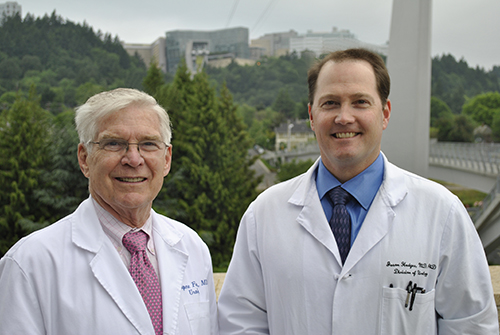Vasectomy Reversal

While a vasectomy is generally considered a permanent procedure, circumstances can persuade some couples to pursue a reversal to re-establish fertility. Sometimes vasectomy reversal can be indicated for treatment of testicular pain associated with vasectomy. For men who are pursuing a vasectomy reversal the success rates are 95 to 98% for returning sperm to the ejaculate at our institution.
The Department of Urology has been instrumental in the development and implementation of vasectomy reversals. Dr. Eugene Fuchs is responsible for pioneering the mini-incision vasectomy reversal approach, first performed here at OHSU in 1978. We also participated in the initial Vasovasostomy Study Section, the most frequently cited reference for statistics regarding the procedure. Thirty five years later, we now provide one of the highest volume vasectomy reversal centers in the nation, having performed over 7,000 to date, and we serve as a primary referral center in the Pacific Northwest for complex or repeat reversals. In 2011, Dr. Fuchs was joined in the practice by Dr. Jason Hedges, who completed residency training with him and also has advanced fellowship training in male sexual health.
Several recent manuscripts have been published illustrating the practices and findings among this large set of patients that underwent vasectomy reversal at OHSU. Some of the results of our findings can be found in:
1. Vasectomy Reversal Outcomes in Men After Testosterone Therapy. Jasper C. Bash, Jamie O. Lo, Akash A. Kapadia, Malachi Mason & Jason C. Hedges Scientific Reports 12, Article number: 19496 (2022)
2. The vasal fluid proteomic profile and microscopic sperm presence at time of vasectomy reversal. Theodore R Saitz, Kevin A Ostrowski, Ann Martinez Acevedo, Jasper C Bash, John Klimek, Eugene F Fuchs, Larry L David, Jason C Hedges. 2020.
3. Reconsidering vasectomy reversal over assisted reproduction in older couples. Akash A Kapadia, Marcus Anthony, Ann Martinez Acevedo, Eugene F Fuchs, Jason C Hedges, Kevin A Ostrowski. 2018.
4. Relating economic conditions to vasectomy and vasectomy reversal frequencies: a multi-institutional study Sharma V, Zargaroff S, Sheth KR, Le BV, Dupree JM, Sandlow JI, Polackwich AS, Hedges JC, Fuchs EF, Goldstein M, Brannigan RE. J Urol. 2014 Jun;191(6)
5. Impact of Gross and Microscopic Vasal Fluid During Vasectomy Reversal on Pregnancy.Ostrowski KA, Polackwich AS, Conlin MJ, Hedges JC, Fuchs EF.J Urol. 2015 Jan 13.
6. Higher outcomes of vasectomy reversal in men with the same female partner as before vasectomy Ostrowski KA, Polackwich AS, Kent J, Conlin MJ, Hedges JC, Fuchs EF J Urol. 2015 Jan;193(1):245-7